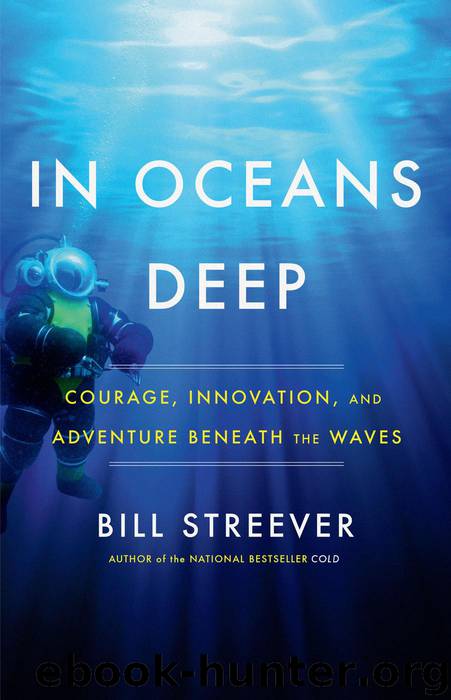In Oceans Deep by Bill Streever

Author:Bill Streever
Language: eng
Format: epub
Publisher: Little, Brown and Company
Published: 2019-07-01T16:00:00+00:00
Through a network of old friends and colleagues, I contact Steve Porter. Like me, he was diving in oil fields by the time he was nineteen years old. Unlike me, he had both the opportunity and willingness to participate in an extremely deep experimental dive in a chamber at Duke University in 1981. With two other volunteers, he was pressurized to what amounted to 2,250 feet below sea level. They lived in a steel can for forty-three days, residing briefly at pressures close to those found a half mile underwater.
“We started,” Steve tells me, “in a chamber called the Golf Ball, a seven-foot-diameter ball on top of a six-foot-diameter vertical cylindrical portion, separated with an aluminum deck between the sphere and cylinder. We lived and took most tests in the top. The deck opened up to provide a ladder to the bottom section, where we had a crapper and the cardiopulmonary test setup. The cardiopulmonary tests were incredibly invasive, with venous and arterial blood sampling and hundreds of inhaled and exhaled gas tests.”
The men pedaled an exercise bicycle, used tweezers to move tiny ball bearings into a narrow tube, dropped washers onto pegs, and played with wrenches and bolts. All of their urine went to laboratories.
They tolerated one another in a space no larger than a typical American walk-in closet.
“Our day started every morning with a venous stick and four samples of blood before breakfast,” he recalls. “We centrifuged the samples to get the cells out of the serum and sent the serum out to the hematologists.”
And there was the challenge of breathing itself. At that depth, breathing requires a certain level of concentration. “We became,” Steve tells me, “fully obligatory mouth breathers.” Their atmosphere was too dense, too thick, to move conveniently through nasal passages. Eating required chewing and swallowing between breaths.
The most tender of steaks, with all of the air squeezed out of them, became tough. The creamiest bowl of ice cream was, at 2,250 feet, squeezed into a thimbleful of flavored ice.
The pressure affected their minds. “Dreams…Yikes, the dreams were amazing. Technicolor, very vivid, very realistic, running the gamut from horror to incredibly erotic. Never had any like them before or since.”
And there was straight-up madness. “We had one subject go stark raving crazy,” Steve tells me of one of his extreme dives. “We had to hit him with enough lithium to make an elephant sleep.”
Through the chamber’s intercom, a psychiatrist outside gave Steve the technical name for the symptoms he was seeing. “The shrink said, ‘Yeah, I think that’s what it is, and I don’t know how you guys are doing it,’” Steve recalls. “‘I can’t even stay in the same room with nuts like this.’”
The decompression schedule had to be made up as the divers ascended. “It turns out the mathematical models used to develop normal decompression tables were completely useless,” he says. Later in life, he says, he learned about fluid dynamics. Normal decompression models assume that fluids—like blood, for example—are incompressible, and at normal diving depths, for all practical purposes they are.
Download
This site does not store any files on its server. We only index and link to content provided by other sites. Please contact the content providers to delete copyright contents if any and email us, we'll remove relevant links or contents immediately.
The Lonely City by Olivia Laing(4768)
Animal Frequency by Melissa Alvarez(4427)
All Creatures Great and Small by James Herriot(4269)
Walking by Henry David Thoreau(3922)
Exit West by Mohsin Hamid(3795)
Origin Story: A Big History of Everything by David Christian(3666)
COSMOS by Carl Sagan(3588)
How to Read Water: Clues and Patterns from Puddles to the Sea (Natural Navigation) by Tristan Gooley(3432)
Hedgerow by John Wright(3316)
How to Read Nature by Tristan Gooley(3291)
The Inner Life of Animals by Peter Wohlleben(3285)
How to Do Nothing by Jenny Odell(3263)
Project Animal Farm: An Accidental Journey into the Secret World of Farming and the Truth About Our Food by Sonia Faruqi(3189)
Origin Story by David Christian(3170)
Water by Ian Miller(3155)
A Forest Journey by John Perlin(3043)
The Plant Messiah by Carlos Magdalena(2900)
A Wilder Time by William E. Glassley(2835)
Forests: A Very Short Introduction by Jaboury Ghazoul(2815)
